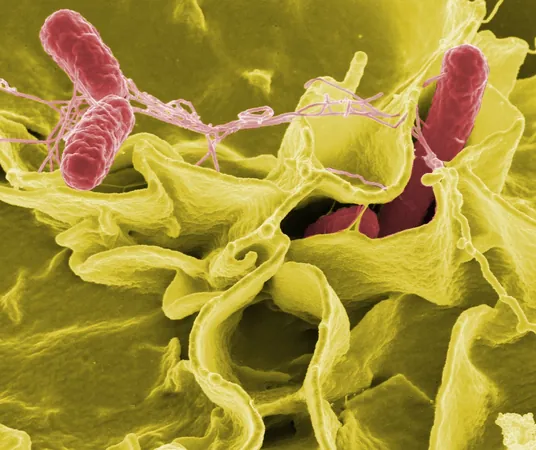
Salmonella Cases Soar to a Decade High in England—Protect Yourself with These Tips!
2025-07-07
Author: Olivia
It's Time to Pay Attention: Salmonella Infections Spike!
Salmonella cases in England have reached alarming levels, marking the highest incidence in ten years, according to the UK Health Security Agency (UKHSA). Last year, an astonishing 10,388 infections were recorded, reflecting a 17% surge from the previous year. Vulnerable populations, particularly children and the elderly, made up approximately 20% of these cases.
Why is This Happening?
Despite a long-term decline in foodborne illnesses, this recent spike in Salmonella hints at deeper issues. A concurrent rise in Campylobacter cases suggests a shared cause, potentially linked to changes in consumer habits or disruptions in the food supply chain.
What Is Salmonella and How Does It Affect You?
Salmonella, one of the leading culprits behind foodborne illnesses globally, leads to salmonellosis, characterized by symptoms like vomiting and diarrhea. Luckily, most infections resolve without medical treatment; however, about 1 in 50 cases can escalate to serious blood infections. In the UK, fatalities are incredibly rare, only occurring in about 0.2% of reported cases.
Sources of Contamination and the Challenge Ahead
This bacteria lurks in a wide array of foods, from raw meats and eggs to unpasteurized milk and even vegetables. The diverse contamination sources complicate stringent control efforts within the food supply. Salmonella can originate from animals, especially livestock, despite extensive safety measures in the farming industry.
Understanding the Increase
While it's too soon to pinpoint the exact causes of this surge, the UKHSA indicates that more robust diagnostic testing has contributed to better detection. Additionally, factors such as shifts in food storage and cooking habits amid a cost-of-living crisis are likely playing a role.
Digging Deeper: The Serotypes of Salmonella
To uncover the reasons behind this increase, further research on the specific strains of Salmonella is crucial. Notably, Salmonella enteritidis and Salmonella Typhimurium are the primary offenders in England. The UKHSA reports an increase in both, but Salmonella enteritidis—often linked to eggs—appears to be leading the charge. While its occurrence in UK poultry has diminished due to past vaccination efforts, the origin of these new infections demands investigation.
Staying Safe: Your Essential Guide
Despite the uptick in cases, UK consumers need not panic. However, practicing good food hygiene is critical. Follow these four key steps to minimize your risk of Salmonella:
1. Cleaning Is Key!
Always wash your hands thoroughly before and after handling food, especially raw meat. Clean your workspace and utensils to prevent cross-contamination.
2. Cook It Right!
Proper cooking can neutralize Salmonella bacteria. Ensure foods are cooked to an internal temperature above 65°C for at least ten minutes. When reheating, bring food to at least 70°C for two minutes.
3. Keep It Chill!
Store raw foods—especially meat and dairy—below 5°C to inhibit bacteria growth. Swiftly cool any leftovers, keeping them at the same temperature.
4. Prevent Cross-Contamination!
Avoid transferring Salmonella from raw foods to those ready to eat. Wash hands and clean surfaces after handling raw meat, and use separate cutting boards for raw ingredients and ready-to-eat items.
Be Proactive!
While most Salmonella infections are mild and resolve in a few days, taking these precautions can significantly reduce your risk. Stay informed and vigilant to keep you and your loved ones safe!









 Brasil (PT)
Brasil (PT)
 Canada (EN)
Canada (EN)
 Chile (ES)
Chile (ES)
 Česko (CS)
Česko (CS)
 대한민국 (KO)
대한민국 (KO)
 España (ES)
España (ES)
 France (FR)
France (FR)
 Hong Kong (EN)
Hong Kong (EN)
 Italia (IT)
Italia (IT)
 日本 (JA)
日本 (JA)
 Magyarország (HU)
Magyarország (HU)
 Norge (NO)
Norge (NO)
 Polska (PL)
Polska (PL)
 Schweiz (DE)
Schweiz (DE)
 Singapore (EN)
Singapore (EN)
 Sverige (SV)
Sverige (SV)
 Suomi (FI)
Suomi (FI)
 Türkiye (TR)
Türkiye (TR)
 الإمارات العربية المتحدة (AR)
الإمارات العربية المتحدة (AR)